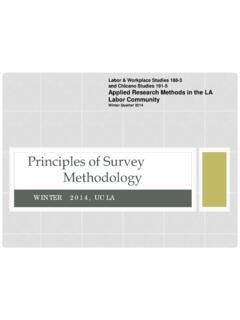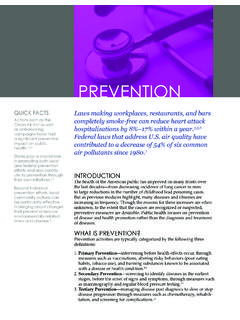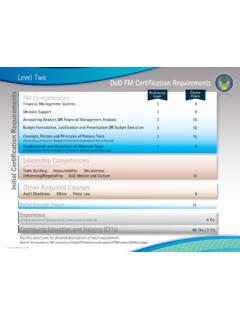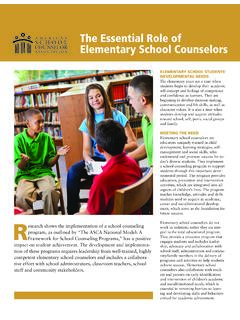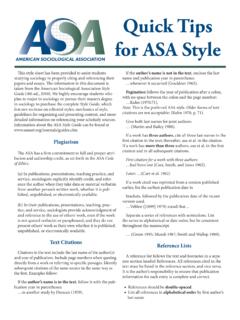Transcription of Participatory A Short Guide Asset Mapping to Community ...
1 ParticipatoryAsset MappingCOMMUNITY RESEARCH Community RESEARCH LABTOOLBOXCOMMUNITY RESEARCH LABTOOLBOXATOOLKITDECEMBER 2011a program ofA Short Guide to Community Based Participatory Action ResearchGUIDE1A Short Guide TO Community BASED Participatory ACTION RESEARCH AcknowledgmentsACKNOWLEDGMENTSH ealthy City, through the Community Research Lab, devel-oped this Guide with funding from First 5 Los Angeles. This and other toolkits can be accessed through the Healthy City website at : Janice C. Burns, ; Deanna Y. Cooke, ; Christine Schweidler, : Taisha Bonilla, and Tahirah Farris, , Woo and Colleen Corcoran / more information, visit or contact us at (213) 989-1300. Copyright Dec. 2011 Advancement Project Healthy CityAll rights reserved.
2 Use and reproduction of these mate-rials in any format should be credited to Advancement Project- Healthy City Community Research Lab. Materials are not to be used or sold for commercial purposes or UsADVANCEMENT PROJECTA dvancement Project ( ) is a public policy change organization rooted in the civil rights movement. We engi neer large-scale systems change to remedy inequality, expand opportunity and open paths to upward mobil ity. Our goal is that members of all communities have the safety, opportunity and health they need to thrive. Advancement Project s Programs include: Educational Equity, Equity in Public Funds, Healthy City, and Urban Peace Institute. HEALTHY CITYH ealthy City ( ) is an information + action resource that unites Community voices, rigor-ous research and innovative technologies to solve the root causes of social inequity.
3 We transform how people access and use information about their communities. As a program of Healthy City, the Community Research Lab partners with Community -based organizations to develop, implement, and disseminate data/ Mapping projects, tools, and workshops that promote Community knowledge and Community Based Participatory Action Research. 2A Short Guide TO Community BASED Participatory ACTION RESEARCH About the ToolboxHealthy City supports communities in identifying, organiz-ing, and sharing its collective voice with decision makers at the local and state levels. Through the Community Research Lab, we share best practices and methods for Community -Based Organizations (CBOs) interested in supporting their strategies with research that combines Community knowledge with Healthy City technology.
4 Toward this aim, we have developed the Community Research Lab Toolbox. The toolbox presents research concepts, methods, and tools through topical guides and toolkits such as Community Research, Participatory Asset Mapping , and a Short Guide to CBPAR (all of which can be accessed at ). It is based on best practices from our work with CBOs and a unique approach to the Community Based Participatory Action Research (CBPAR) framework, which promotes research that: 1. Starts with issues and strategies then produces analysis that informs action2. Uses Mapping technology to engage organizations in the research process3. Is both Community -based and place-based, often focusing on a geographic place such as a neighborhoodThe toolbox s CBPAR framework explicitly focuses on Community -based organizations that bring together com-munity members to visualize and actualize research and its outcomes.
5 This includes non-profit organizations that operate in specific, local communities and are staffed by, work with, represent, assist, and/or advocate on behalf of residents of those communities on issues that affect their quality of life. These organizations have worked to gain trust among Community members and have brought together a spectrum of people with varying ideas and perspectives that unite around a particular set of concerns relevant to a large portion of the Community . Though it may have utility for other groups, it supports these organizations whose work directly engages Community members in creating change. About this GuideHow can this Guide be used? +As an Introduction to the CBPAR framework, which democratizes how research is conducted in communities and guides the research methods covered in all of the Community Research Lab toolkits +As a workbook for workshops on understanding how to apply the CBPAR framework to research that is place-based and informs social action.
6 +As a resource and information Guide for conducting research within the CBPAR will you find in this Guide ? +Key research concepts and methods +Glossary terms in BOLD +Notes like the one below to write down any thoughts or ideas you have as you readHOW CAN THIS Guide BE USEFUL IN YOUR SPECIFIC WORK OR PROJECTS?3A Short Guide TO Community BASED Participatory ACTION RESEARCH ContentsI. WHAT IS Community BASED Participatory ACTION RESEARCH? 5II. CBPAR AND PLACE-BASED RESEARCH 6 III. Community PARTICIPATION AND ENGAGEMENT 7I V. BENEFITS OF CBPAR 8V. RESEARCH ETHICS IN CBPAR 9VI. PLANNING A CBPAR PROJECT 10 VII. GLOSSARY 14 VIII. RESOURCES AND REFERENCES 17 This page left intentionally Short Guide TO Community BASED Participatory ACTION RESEARCH Community Based Participatory Action Research (CBPAR) is a collaborative approach to research that involves all stakeholders throughout the research process, from establishing the research question, to devel-oping data collection tools, to analysis and dissemination of findings.
7 It is a research framework that aims to address the practical concerns of people in a Community and fundamentally changes the roles of researcher and who is being researched. The CBPAR framework begins with a Community s issue, proposed action, or strategy and then supports or enhances this action with research that is Community based and It frames research to be: Community BASED grounded in the needs, issues, concerns, and strategies of communities and the com-munity-based organizations that serve themPARTICIPATORY directly engaging communities and Community knowledge in the research process and its outcomesACTION BASED AND ORIENTED supporting and/or enhancing the strategic action that leads to Community transformation and social changeBy its nature, CBPAR is applied research.
8 It seeks to change issues that are critical to communities and focuses on engaging Community members in research directed at addressing their social concerns. It is derived from several research approaches that are based on commu -nities collaborating with researchers (ex. Community Based Research), or Community members engaging in all aspects of the research process (ex. Participatory Action Research, or Action Research). As a frame-work for research conducted in, for, and by communities, CBPAR recognizes that: + Community knowledge is irreplaceable and provides key insights that ground-truths administrative data +Complex social issues often cannot be well understood or resolved by expert research +Interventions from outside of the Community have often had disappointing results +Communities should have equal inclusion and collaboration in the identification, research, and resolution of Community issues +There is value and legitimacy in the knowledge of individuals, families, and others in the Community CBPAR has a specific goal of collaborative research that engages stakeholders in an iterative research and action process.
9 The diagram below shows that CBPAR links research and action, recognizing that social action requires further research and social research requires further What is Community Based Participatory Action Research? 6A Short Guide TO Community BASED Participatory ACTION RESEARCH Often, the work of CBOs centers on a specific geographic Community that can be defined by the streets, landmarks, or other physical boundaries. Therefore, the CBPAR framework discussed in this Guide promotes Community research that focuses on a geographic place or neighbor-hood. It recognizes that CBOs often refer to Community as a place, or a physical, geographic space or location, such as a neighborhood, in which issues and interven-tions are concentrated and change is intended to occur.
10 This framework serves as a foundation to Community research that is Community -based (engages the com-munity) and place-based (focuses on a geographic area). The work of CBOs includes place-based strategies that build upon the existing strengths and address the multiple issues of the places they work in. Building upon this holis-tic model of neighborhood change, place-based research, within the CBPAR framework, uses comprehensive, multi-sectored, Asset -based, long-term, collaborative, innovative, and analytical research methods. It aims to apply methods of data collection and analysis to generate findings that have highly practical results. The audience for such findings is typically made up of Community mem-bers, practitioners, and local policymakers who wish to design an intervention that benefits a Community .
